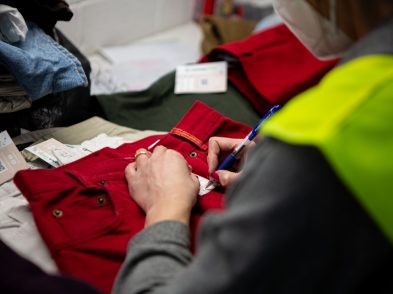A new report by researchers from the National Research Council (CNR) and Geosciences Institute at the University of Florence provides scientific proof that Michelangelo’s David risks crumbling under his own weight — though only in the case of high-stress conditions such as an earthquake. This news has been circulating on international portals after it was released by ANSA earlier this month; TF got to the bottom of it by accessing the scientific report, and by consulting Prof. A. Victor Coonin, author of the forthcoming book on Michelangelo’s David published by The Florentine Press and available here.
The report confirms findings made in 1851 and further studied by Antonio Borri through computer modeling in 2005. According to Borri, the cracks at the base of the David were likely caused by a slight tilt in the statue due to a shifting of the ground underneath it. Coonin writes that the cracks may have developed ‘in 1844 when Florence was subject to flooding, or in 1847 when additional weight was placed on the David while it was being cast by Clemente Papi. The tilting was corrected in 1873, when the statue was installed in the Accademia Gallery, and the cracks have not worsened since.’ (Coonin, From Marble to Flesh, p. 199).
The 2014 study involved creating scale gypsum models of the David and subjecting them to extreme force in a centrifuge. Centrifuge analogue models are a recognized method of scientific analysis of stability and have been used on the Leaning Tower of Pisa. ‘The gypsum statue was placed vertically in the centrifuge and subjected to increasing rotational speeds up to rupture that occurred at about 1950 rpm (i.e., ∼ 550 g at the the point in the model geometrically corresponding to the centre of mass in the prototype. The statue collapsed forward, breaking in correspondence of sharp fractures that developed on both ankles at similar elevations from the base of the statue.’ (Corti et al, p. 4) An increase in angle increases likelyhood of fracture. In sum, in conditions of extreme stress, the David could indeed crack.

Responding to the findings, superintendent of Florence’s museums, Cristina Acidini, noted, ‘Since 2001, David’s micro-fractures have been monitored constantly, and no variation has been recorded to date.’ Essentially, the study is scientifically valid but does not provide new information, only confirmation of past information on the stability of the work of art.
Various solutions have been proposed in order to preserve the sculpture from potential future harm. Anti-seismic bases have been used to protect other statues in Italy and could be created for the David. Coonin suggests this as the most feasible option, and such a base has already been designed. Other suggestions involve moving the David to an earthquake proof museum outside of the city. It should not come as a surprise that no action has been taken, since decisions around this and many other important works of art tend to take many decades to be studied and executed. History shows us that the David is particularly subject to attention, discussion and polemics, of which this is just the latest in a centuries-long story.
If you are interested in the complex history of Michelangelo’s David, its reception and preservation, purchase a copy of Victor Coonin’s From Marble to Flesh. The Biography of Michelangelo’s David, today.
REFERENCES
Antonio Borri and Andrea Grazini, “Diagnostic analysis of the lesions and stability of Michelangelo’s David,” La stabilità delle grandi statue: Il David di Michelangelo, ed. Antonio Borri, Rome, 2005
Antonio Borri, Indagine georadar sul basamento del David di Michelangelo, Naples, 2010.
Giacomo Corti, et al., “Modelling the failure mechanisms of Michelangelo’s David through small- scale centrifuge experiments,” Journal of Cultural Heritage, 2014, http://dx.doi.org/10.1016/j. culher.2014.03.001
Gerardo De Canio, “Marble devices for seismic isolation of highly vulnerable statues”: http:// www.heritageportal.eu/images/stories/Marble_devices_for_seismic_isolation_of_highly_ vulnerable_statues_Gerardo_de_Canio.pdf.







